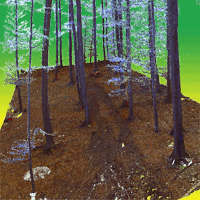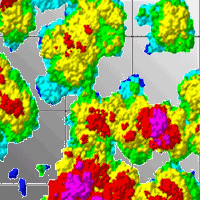
Below- and above-ground biomass, structure and patterns in ancient lowland coppices
Tomás Vrška (1-2), David Janík (1) , Marcela Pálková (1-2), Dusan Adam (1), Jan Trochta (1)
iForest - Biogeosciences and Forestry, Volume 10, Issue 1, Pages 23-31 (2016)
doi: https://doi.org/10.3832/ifor1839-009
Published: Nov 06, 2016 - Copyright © 2016 SISEF
Research Articles
Collection/Special Issue: IUFRO division 8.02 - Mendel University Brno (Czech Republic) 2015
Coppice forests: past, present and future
Guest Editors: Tomas Vrska, Renzo Motta, Alex Mosseler
Abstract
Ancient coppice woods are areas that reflect long-term human influence and contain high species biodiversity. In this type of forest we aimed to: (i) analyze the below- and above ground biomass of stools and estimate the age of largest stool; (ii) define a “zone of interference” for coppices; (iii) describe and classify variability in the shape and size of coppice stools; (iv) define the specific characteristics of the spatial distribution of stems and stools. The study was conducted in the Podyjí National Park, Czech Republic, where two old oak coppice stands were fully stem mapped: Lipina (3.90 ha) and Šobes (2.37 ha). Cores were processed using TimeTable and PAST4. Below- and above-ground biomass of the largest stools was computed using the data from terrestrial laser scanner. Tree zones of influence were analyzed with V-Late landscape analysis tools using Shape Index. The pair correlation function and L function were used to describe the spatial patterns of trees with DBH ≥ 7 cm, and the null model of Complete Spatial Randomness and Matérn cluster process were tested. For a modeled old stool, we estimated a ratio of 2:1 for above/below ground volume with no reduction of below ground biomass regarding the hollow roots. The age of the largest stool was estimated 825 ± 145 (SE) years. An “Inner Zone of Influence” was defined, with a total area covering 323 m2 ha-1. The median area of this zone in both plots was 0.40 m2 for all trees, 0.23 m2 for singles and 0.87 m2 for stools. The Matérn cluster process was successfully fitted to our empirical data. In this model, the mean cluster radius ranged between 1.9 to 2.1 m and mean number of points per cluster was 1.7 and 1.9. The most prevalent characteristics of these ancient oak coppices were their compact shape and clustered spatial distribution up to 10 m.
Keywords
Oak, Stools, Spatial Patterns, Root System, Terrestrial Laser Scanning, Ancient Coppices
Authors’ Info
Authors’ address
David Janík
Marcela Pálková
Dusan Adam
Jan Trochta
Silva Tarouca Research Institute, Department of Forest Ecology, Lidická 25/27, 602 00 Brno (Czech Republic)
Marcela Pálková
Faculty of Forestry and Wood Technology, Mendel University in Brno, Department of Silviculture, ZemÄ›dÄ›lská 3, 613 00 Brno (Czech Republic)
Corresponding author
Paper Info
Citation
Vrška T, Janík D, Pálková M, Adam D, Trochta J (2016). Below- and above-ground biomass, structure and patterns in ancient lowland coppices. iForest 10: 23-31. - doi: 10.3832/ifor1839-009
Academic Editor
Francesco Ripullone
Paper history
Received: Aug 31, 2015
Accepted: Aug 12, 2016
First online: Nov 06, 2016
Publication Date: Feb 28, 2017
Publication Time: 2.87 months
Copyright Information
© SISEF - The Italian Society of Silviculture and Forest Ecology 2016
Open Access
This article is distributed under the terms of the Creative Commons Attribution-Non Commercial 4.0 International (https://creativecommons.org/licenses/by-nc/4.0/), which permits unrestricted use, distribution, and reproduction in any medium, provided you give appropriate credit to the original author(s) and the source, provide a link to the Creative Commons license, and indicate if changes were made.
Web Metrics
Breakdown by View Type
Article Usage
Total Article Views: 51935
(from publication date up to now)
Breakdown by View Type
HTML Page Views: 43216
Abstract Page Views: 3000
PDF Downloads: 4293
Citation/Reference Downloads: 77
XML Downloads: 1349
Web Metrics
Days since publication: 3324
Overall contacts: 51935
Avg. contacts per week: 109.37
Citation Metrics
Article Citations
Article citations are based on data periodically collected from the Clarivate Web of Science web site
(last update: Mar 2025)
Total number of cites (since 2017): 17
Average cites per year: 1.89
Publication Metrics
by Dimensions ©
Articles citing this article
List of the papers citing this article based on CrossRef Cited-by.
References
Spatstat: an R package for analysing spatial point patterns. Journal of Statistic Software 12: 1-42.
Gscholar
Contribution to the discussion of Dr Ripley’s paper. Journal of the Royal Statistical Society (Series B) 39: 193-195.
Gscholar
Lesní vegetace NP Podyjí. [The Forest Vegetation in Podyjí National Park]. Academia, Praha, Czech Republic. pp. 166. [in Czech]
Gscholar
Man and landscape in the Somerset Levels. In: “The Effect of Man on the Landscape: the Lowland Zone” (Limbrey S, Evans JG, eds). CBA Research Report No. 21, Council for British Archaeology, London, UK, pp. 86-89.
Gscholar
Coppice fingerprints in growth patterns of pedunculate oak (Quercus robur). In: “TRACE - Tree Rings in Archaeology, Climatology and Ecology” (Levanic T, Gricar J, Hafner P, Krajnc R, Jagodic S, Gärtner H, Heinrich I, eds). Otočec, Slovenia, pp. 54-60.
Online | Gscholar
The ecological basis for oak silviculture in Eastern North America. In: “Oak Forest Ecosystems: Ecology and Management for Wildlife” (McShea WJ, Healy WM eds). The Johns Hopkins University Press, Baltimore, USA, pp. 60-79.
Gscholar
Statistical analysis of spatial point patterns (2nd edn). Hodder Arnold, London, UK, pp. 159.
Gscholar
Effects of data quality on analysis of ecological pattern using the K(d) statistical function. Ecology 83: 35-46.
Gscholar
Holzanatomische Analyse diagnostischer Merkmale einer Freilegungsreaktion in Jahrringen von Koniferenwurzeln zur Rekonstruktion geomorphologischer Prozesse. [Wood-anatomical analysis of diagnostic characteristics of an exposure reaction in tree rings of coniferous roots to reconstruct geomorphological processes]. Rheinischen Friedrich-Wilhelms-Universität, Bonn, Germany, pp. 118. [in German]
Gscholar
Structure and Ecology of oak woods in the Podyjí National Park as exemplified by the Lipina locality. Thayensia 7: 175-206.
Gscholar
Korenový systém dubu letního a zimního: rhizologická studie. [Root system of oaks]. Nakladatelství CSAV, Praha, Czech Republic. pp. 85. [in Czech]
Gscholar
vLATE Extension für ArcGIS - vektorbasiertes Tool zur quantitativen Landschaftsstrukturanalyse [vLATE - Vector-based Landscape Analysis Tools Extension for ArcGIS}. In: Proceedings of the Conference “ESRI Anwenderkonferenz” [ESRI User-conference]. Innsbruck (Austria) 8-10 Oct 2003. [CD-ROM] [in German]
Online | Gscholar
Fragstats: spatial pattern analysis program for quantifying landscape structure, version 2.0. Oregon State University, Corvallis, USA, pp. 134.
Gscholar
Starší doba kamenná v Podyjí: Současný stav a perspektivy [Old stone age in the river Dyje region: an overview and perspectives]. Thayensia 7: 291-303. [in Czech]
Gscholar
Plán péče o Národní park Podyjí a jeho ochranné pásmo. [Management plan for Podyjí National Park and its protective zone]. Správa NP Podyjí, Znojmo, Czech Republic, pp. 316. [in Czech]
Gscholar
Atlas podnebí Ceska. [Climate atlas of Czechia]. Czech Hydrometeorological Institute, Praha, Czech Republic, pp. 255. [in Czech]
Gscholar
Historický vývoj lesu na území NP Podyjí a v bližším okolí do roku 1948. [Historical development of forests in Podyjí National Park until 1948]. Thayensia 1: 101-124. [in Czech]
Gscholar
Výsledky neprímých prevodu parezin pretvárením. [The results of coppice transformation management]. Lesnictví 12: 1061-1096. [in Czech]
Gscholar

















